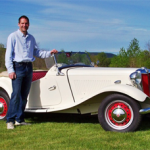No mail this month, so I will discuss the importance of a good parts counter person.
Recently, I found my self needing to borrow a car. I asked dad if I could borrow his Subaru. The A/C clutch was broken and he asked me if I could fix it while I had the car. The bearing in the clutch pulley was broken. He had taken it to the dealer, and the Subaru dealer stated that the compres-sor needed to be replaced. The compressor was fine, it was only the clutch bearing that was the problem. I pulled the bearing and was fortunate enough to still be able to read the numbers off it. I grabbed my calipers and set off to buy a bearing. The first stop was Advance Auto Parts. The guy behind the counter tried to look it up, then told me that the part was not available. He was trying to look it up by year, make, model and part. I asked him to try to look it up by the bearing number… No luck. I pulled out my calipers and began to measure it so he could look it up by size. He had no idea what the calipers were, and inquisitively asked me what they were and what they did. He then told me there was no way to look up a bearing by it’s dimensions, or by the bearing number. A quick Google search by the bearing number showed the bearing to be available. A google search is often quite helpful in trying to find an odd ball part. Having this information in hand can help the guy on the other side of the counter find a part for you. My next stop was Bond Auto. The guy quickly checked the application by looking at year, make and model, then just used the bearing number. Several minutes later he told me the bearing was available, but would take a few days to get in. He then suggested I try Bearing Specialty Supply in Williston, as they could get it faster. So, with the help of a competent parts counter guy I was able to fix the car for less than ten percent of the cost of a new compressor. If you have the time, it is usually cheaper to order a part on line. If you need the part quickly, or you are not sure what it looks like and want to hold it in your hand before you pay for it, it is better to use the local auto parts store. A decent parts person is a valuable asset; whether it is the local auto parts store or the parts counter at a dealership. A good parts counter person will often tell me if other parts are often needed, and what issues mechanics have run into when servicing a particular part. This information can be quite helpful. They can also tell me how often they sell a particular part…this is helpful information too. I have found the parts guys at both Bond and Napa to be quite helpful. The other guys… Not so much…
 Please email all inquiries to: Dave
Please email all inquiries to: Dave
or snail mail
32 Turkey Hill Road
Richmond VT 05477











